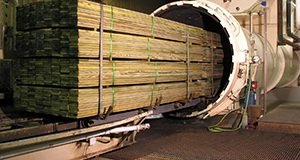This 6-page document describes the purpose of applying preservatives to various wood products. A description of wood preservatives registered for use in Florida is also provided. Written by Frederick M. Fishel and published by the UF/IFAS Agronomy Department, July 2018.
https://edis.ifas.ufl.edu/pi276
Tag: Wood
Preserving Woodenware in Beekeeping Operations (ENY125/AA244)
 The predominant material used to construct honey bee colonies in the U.S. is wood. Though honey bee hive components are simple in design, they are subjected to many extreme management techniques that cause wear and tear, ultimately shortening the life of the equipment. This article discusses how to protect colony woodenware, particularly the pieces that are exposed to the elements. These include the bottom board, hive body/supers, and lids. This 4-page fact sheet was written by J. D. Ellis, W. H. Kern, and C. M. Zettel Nalen, and published by the UF Department of Entomology and Nematology, June 2012.
The predominant material used to construct honey bee colonies in the U.S. is wood. Though honey bee hive components are simple in design, they are subjected to many extreme management techniques that cause wear and tear, ultimately shortening the life of the equipment. This article discusses how to protect colony woodenware, particularly the pieces that are exposed to the elements. These include the bottom board, hive body/supers, and lids. This 4-page fact sheet was written by J. D. Ellis, W. H. Kern, and C. M. Zettel Nalen, and published by the UF Department of Entomology and Nematology, June 2012.
http://edis.ifas.ufl.edu/aa244
The Association between One Particular Green Building Program and the Use of Environmentally Certified Wood by US Homebuilders (FCS3307/FY1301)
 A recent survey of US homebuilders shows that there is an emerging trend for smaller- and medium-sized homebuilders to begin using the LEED for Homes green building program in the near future. Half of the homebuilders sampled desire to receive “green-building points,” and one way to do so is by using environmentally certified wood. LEED for Homes appears to have increased US homebuilder awareness of and use of environmentally certified wood. This 3-page fact sheet was written by Randall A. Cantrell, Indroneil Ganguly, Ivan Eastin, and Tait Bowers, and published by the UF Department of Family Youth and Community Sciences, March 2012.
A recent survey of US homebuilders shows that there is an emerging trend for smaller- and medium-sized homebuilders to begin using the LEED for Homes green building program in the near future. Half of the homebuilders sampled desire to receive “green-building points,” and one way to do so is by using environmentally certified wood. LEED for Homes appears to have increased US homebuilder awareness of and use of environmentally certified wood. This 3-page fact sheet was written by Randall A. Cantrell, Indroneil Ganguly, Ivan Eastin, and Tait Bowers, and published by the UF Department of Family Youth and Community Sciences, March 2012.
http://edis.ifas.ufl.edu/fy1301
SSFOR17/FR130 Steps to Marketing Timber
Revised! SSFOR17, a 7-page fact sheet by Chris Demers and Alan Long, provides forest landowners some important guidelines to follow when planning and conducting a timber sale. Includes references. Published by the UF School of Forest Resources and Conservation, February 2010.
http://edis.ifas.ufl.edu/fr130
